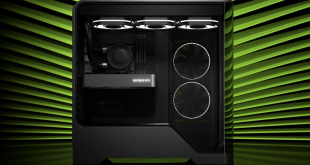We are using the AMD Crimson Edition Display Driver, Version 16.17.3 and Nvidia ForceWare 368.81 driver. The Titan X has been tested with the 369.05 driver.
We are using a custom Titan Bayonet system supplied by Overclockers UK as the basis of our test system today. Read more on this system over HERE.
Case: Phanteks Enthoo Evolv ATX Mid Tower
Processor: Intel 6700K @ 4.4ghz
Memory: Corsair Vengeance LPX 16GB (2x8GB) @ 3000mhz
Motherboard: ASUS Z170-E DDR4 ATX Motherboard
Power Supply: Super Flower Leadex 850W Gold Certified
Software: Microsoft Windows 10 64 Bit
SSD: Samsung 250GB 850 EVO
HDD: Seagate 1TB 7,200 rpm 64MB Cache.

If you want to purchase this system yourself head to THIS page on OCUK.
Graphics cards:
Nvidia Titan X (Pascal) – (1,418 mhz core/ 1,531 mhz boost / 1,251 mhz (10Gbps effective) memory)
Comparison Cards on test:
Asus RX 480 Strix Gaming OC AURA RGB – (1,330mhz core / 2,000 (8Gbps effective) memory)
MSI GTX 1080 Gaming X 8G RGB SLI– (1,683mhz core / 1,823 mhz boost / 5000 mhz memory)
Palit GTX 1080 GameRock Premium Edition – (1,747mhz core / 1,886mhz boost / 5256 mhz memory)
MSI GTX 1080 Gaming X 8G RGB – OC Mode (1,709mhz core / 1,849mhz boost / 5,056 mhz memory)
Gigabyte GTX 1080 G1 Gaming RGB (1721 mhz core / 1860 mhz boost / 5,005 mhz memory)
Nvidia GTX 1080 Founders Edition (1607mhz core/ 1733mhz boost / 5,005 mhz memory)
Nvidia GTX 1070 Founders Edition (1506mhz core/ 1683mhz boost / 4,006 mhz memory)
Sapphire RX 480 Nitro + OC 8GB – (1,342mhz core / 2,000 mhz (8Gbps effective) memory)
Sapphire RX 480 Nitro + OC 4GB – (1,306mhz core / 1,750 mhz (8Gbps effective) memory)
Sapphire R9 390 Nitro 8GB (Rev 2 w/ backplate). (1040mhz core / 1,500 mhz memory)
Sapphire R9 295X2 (1,018 mhz core / 1,250mhz memory)
AMD R9 Fury X (1,050 mhz core / 500 mhz memory)
AMD R9 Nano (1,000mhz core / 500 mhz memory)
Gigabyte GTX980 Ti XTREME Gaming (1,216 mhz core / 1800mhz memory)
Nvidia GTX Titan Z (706 mhz core / 1,753 mhz memory)
Nvidia GTX Titan X (1,000 mhz core / 1,753 mhz memory)
Asus GTX980 Strix (1,178 mhz core / 1,753 mhz memory)
Nvidia GTX980 Ti (1,000 mhz core / 1,753 mhz memory)
Sapphire R9 390X Tri-X 8GB (1,055 mhz core / 1,500 mhz memory)
Sapphire R9 390 Nitro 8GB (1,010 mhz core / 1,500 mhz memory)
Software:
Windows 10 64 bit
Unigine Heaven Benchmark
3DMark 11
3DMark
Fraps Professional
Steam Client
FurMark
Games:
Ashes Of the Singularity
Dirt Rally
Hitman 2016
Middle Earth: Shadow Of Mordor
Rise Of the Tomb Raider
Grand Theft Auto 5
Metro Last Light Redux
Games added:
Doom 2016 (Open GL)
Total War: Warhammer
(we have been unable to test all graphics cards with Doom 2016 and Total War: Warhammer, so a selected list of hardware appears on these pages).
Additional equipment:
Leica S-E (006) medium format camera with 100mm Leica F2 lens.
We perform under real world conditions, meaning KitGuru tests games across five closely matched runs and then average out the results to get an accurate median figure. If we use scripted benchmarks, they are mentioned on the relevant page.
Game descriptions edited with courtesy from Wikipedia.
 KitGuru KitGuru.net – Tech News | Hardware News | Hardware Reviews | IOS | Mobile | Gaming | Graphics Cards
KitGuru KitGuru.net – Tech News | Hardware News | Hardware Reviews | IOS | Mobile | Gaming | Graphics Cards




I may be inclined to getting two 1080’s before I ever get a Titan. o,O
Clocks on your overclock seem a bit conservative – I’ve managed to hold a stable +235 core / 675 memory on both cards, giving me a base clock of 1655 and boost to 1770, with a memory clock of 1420, giving me 11300 effective.
Final boost with their boost 3.0 puts me in the 2150-2180 core clock range. Can’t wait to stick waterblocks on them.
and take the wife for supper , damn! 😉
the joys of the silicon lottery I am afraid. I have recently got another Titan X, and it overclocks quite a bit higher.
Yeah it seems I’ve gotten lucky – really lucky in fact, over the last few years. These tx-p’s of mine both top out near 2200 core / 11500 mem, my previous tx-maxwell’s could boost to a shade over 1550 core, and my 5960x can sustain 5.1ghz across all cores @ 1.42v, and I can push a single core to 5.6GHz. Feels like I get danmed lucky, a lot.
Waterblocks for the tx-p’s have become a more complicated problem though – I was planning on going with EKWB for the setup, but it seems the nvidia HB sli bridge the pascal cards use won’t fit with their pascal blocks, so I’ll need another solution there.
It’s kind of crazy to think that if you notice, it took in most cases until the Pascal Titan X and in others the 1080 to beat the 295×2 in a lot of benchmarks. Kind of neat that even if you bought the 295×2 at full retail of $1500USD (in the states) in took two years, a node shrink from 28nm to 16nm, and a Video Card costing $1200 to beat it in a lot of cases.
Are they not benchmarking Doom in Vulkan?
It’s neat that a single card with only around 70% of the shader cores can be equal in performance and consume half the power.
The 295×2 was fast no doubt about it, but by no means was it particularly impressive. Hot as hell, and needed a beastly power supply to feed it. And thats without overclocking.